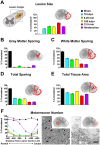Derivation of multivariate syndromic outcome metrics for consistent testing across multiple models of cervical spinal cord injury in rats
- PMID: 23544088
- PMCID: PMC3609747
- DOI: 10.1371/journal.pone.0059712
Derivation of multivariate syndromic outcome metrics for consistent testing across multiple models of cervical spinal cord injury in rats
Abstract
Spinal cord injury (SCI) and other neurological disorders involve complex biological and functional changes. Well-characterized preclinical models provide a powerful tool for understanding mechanisms of disease; however managing information produced by experimental models represents a significant challenge for translating findings across research projects and presents a substantial hurdle for translation of novel therapies to humans. In the present work we demonstrate a novel 'syndromic' information-processing approach for capitalizing on heterogeneous data from diverse preclinical models of SCI to discover translational outcomes for therapeutic testing. We first built a large, detailed repository of preclinical outcome data from 10 years of basic research on cervical SCI in rats, and then applied multivariate pattern detection techniques to extract features that are conserved across different injury models. We then applied this translational knowledge to derive a data-driven multivariate metric that provides a common 'ruler' for comparisons of outcomes across different types of injury (NYU/MASCIS weight drop injuries, Infinite Horizons (IH) injuries, and hemisection injuries). The findings revealed that each individual endpoint provides a different view of the SCI syndrome, and that considering any single outcome measure in isolation provides a misleading, incomplete view of the SCI syndrome. This limitation was overcome by taking a novel multivariate integrative approach for leveraging complex data from preclinical models of neurological disease to identify therapies that target multiple outcomes. We suggest that applying this syndromic approach provides a roadmap for translating therapies for SCI and other complex neurological diseases.
Conflict of interest statement
Figures






Similar articles
-
Combined SCI and TBI: recovery of forelimb function after unilateral cervical spinal cord injury (SCI) is retarded by contralateral traumatic brain injury (TBI), and ipsilateral TBI balances the effects of SCI on paw placement.Exp Neurol. 2013 Oct;248:136-47. doi: 10.1016/j.expneurol.2013.06.006. Epub 2013 Jun 13. Exp Neurol. 2013. PMID: 23770071 Free PMC article.
-
Behavioral and histological characterization of unilateral cervical spinal cord contusion injury in rats.J Neurotrauma. 2006 Jan;23(1):36-54. doi: 10.1089/neu.2006.23.36. J Neurotrauma. 2006. PMID: 16430371
-
Graded histological and locomotor outcomes after spinal cord contusion using the NYU weight-drop device versus transection.Exp Neurol. 1996 Jun;139(2):244-56. doi: 10.1006/exnr.1996.0098. Exp Neurol. 1996. PMID: 8654527
-
Contrasting Experimental Rodent Aftercare With Human Clinical Treatment for Cervical Spinal Cord Injury: Bridging the Translational "Valley of Death".J Neurotrauma. 2023 Dec;40(23-24):2469-2486. doi: 10.1089/neu.2023.0314. Epub 2023 Nov 10. J Neurotrauma. 2023. PMID: 37772694 Free PMC article. Review.
-
Sensorimotor behaviour following incomplete cervical spinal cord injury in the rat.Behav Brain Res. 2005 Dec 7;165(2):147-59. doi: 10.1016/j.bbr.2005.07.025. Epub 2005 Sep 12. Behav Brain Res. 2005. PMID: 16157393 Review.
Cited by
-
Association Between Magnetic Resonance Imaging-Based Spinal Morphometry and Sensorimotor Behavior in a Hemicontusion Model of Incomplete Cervical Spinal Cord Injury in Rats.Brain Connect. 2020 Nov;10(9):479-489. doi: 10.1089/brain.2020.0812. Epub 2020 Oct 29. Brain Connect. 2020. PMID: 32981350 Free PMC article.
-
Combined SCI and TBI: recovery of forelimb function after unilateral cervical spinal cord injury (SCI) is retarded by contralateral traumatic brain injury (TBI), and ipsilateral TBI balances the effects of SCI on paw placement.Exp Neurol. 2013 Oct;248:136-47. doi: 10.1016/j.expneurol.2013.06.006. Epub 2013 Jun 13. Exp Neurol. 2013. PMID: 23770071 Free PMC article.
-
Testing a Multivariate Proteomic Panel for Traumatic Brain Injury Biomarker Discovery: A TRACK-TBI Pilot Study.J Neurotrauma. 2019 Jan 1;36(1):100-110. doi: 10.1089/neu.2017.5449. Epub 2018 Sep 27. J Neurotrauma. 2019. PMID: 30084741 Free PMC article.
-
Long-Term Effects of Neural Precursor Cell Transplantation on Secondary Injury Processes and Functional Recovery after Severe Cervical Contusion-Compression Spinal Cord Injury.Int J Mol Sci. 2021 Dec 3;22(23):13106. doi: 10.3390/ijms222313106. Int J Mol Sci. 2021. PMID: 34884911 Free PMC article.
-
FAIR SCI Ahead: The Evolution of the Open Data Commons for Pre-Clinical Spinal Cord Injury Research.J Neurotrauma. 2020 Mar 15;37(6):831-838. doi: 10.1089/neu.2019.6674. Epub 2019 Dec 6. J Neurotrauma. 2020. PMID: 31608767 Free PMC article. Review.
References
-
- Chan AW, Hrobjartsson A, Haahr MT, Gotzsche PC, Altman DG (2004) Empirical evidence for selective reporting of outcomes in randomized trials: comparison of protocols to published articles. Jama 291: 2457–2465. - PubMed
-
- Evans JA, Foster JG (2011) Metaknowledge. Science 331: 721–725. - PubMed
-
- Sena E, van der Worp HB, Howells D, Macleod M (2007) How can we improve the pre-clinical development of drugs for stroke? Trends Neurosci 30: 433–439. - PubMed
Publication types
MeSH terms
Grants and funding
- R01 NS031193/NS/NINDS NIH HHS/United States
- F32NS079030/NS/NINDS NIH HHS/United States
- R01 NS067092/NS/NINDS NIH HHS/United States
- R01 NS069537/NS/NINDS NIH HHS/United States
- NS038079/NS/NINDS NIH HHS/United States
- NS069537/NS/NINDS NIH HHS/United States
- P01 AG014930/AG/NIA NIH HHS/United States
- R21 AG032518/AG/NIA NIH HHS/United States
- AG032518/AG/NIA NIH HHS/United States
- NS067092/NS/NINDS NIH HHS/United States
- NS031193/NS/NINDS NIH HHS/United States
- R01 NS038079/NS/NINDS NIH HHS/United States
- F32 NS079030/NS/NINDS NIH HHS/United States
LinkOut - more resources
Full Text Sources
Other Literature Sources
Medical

